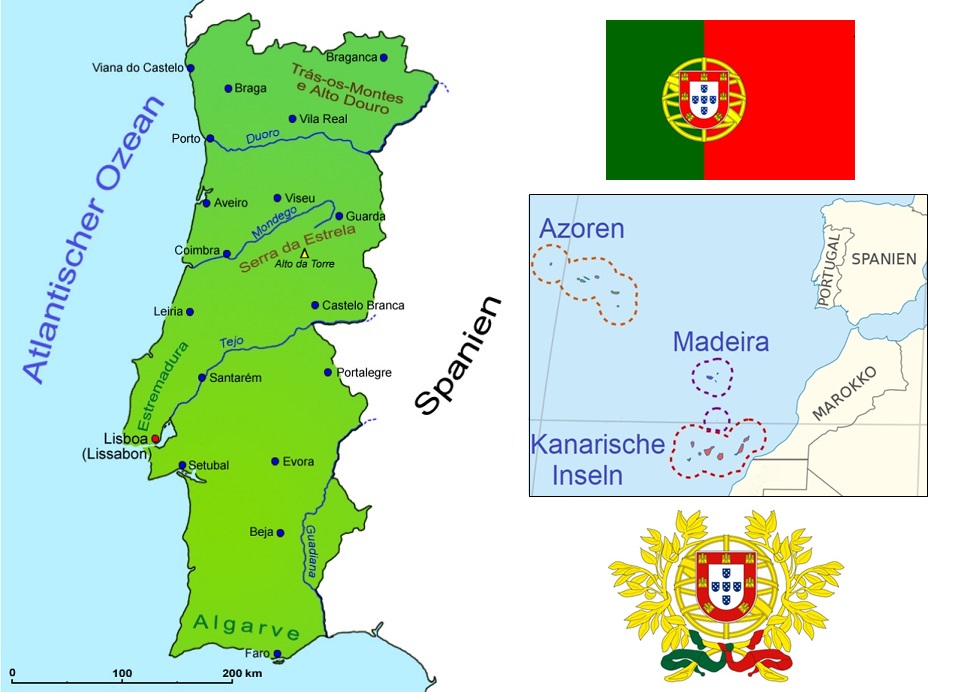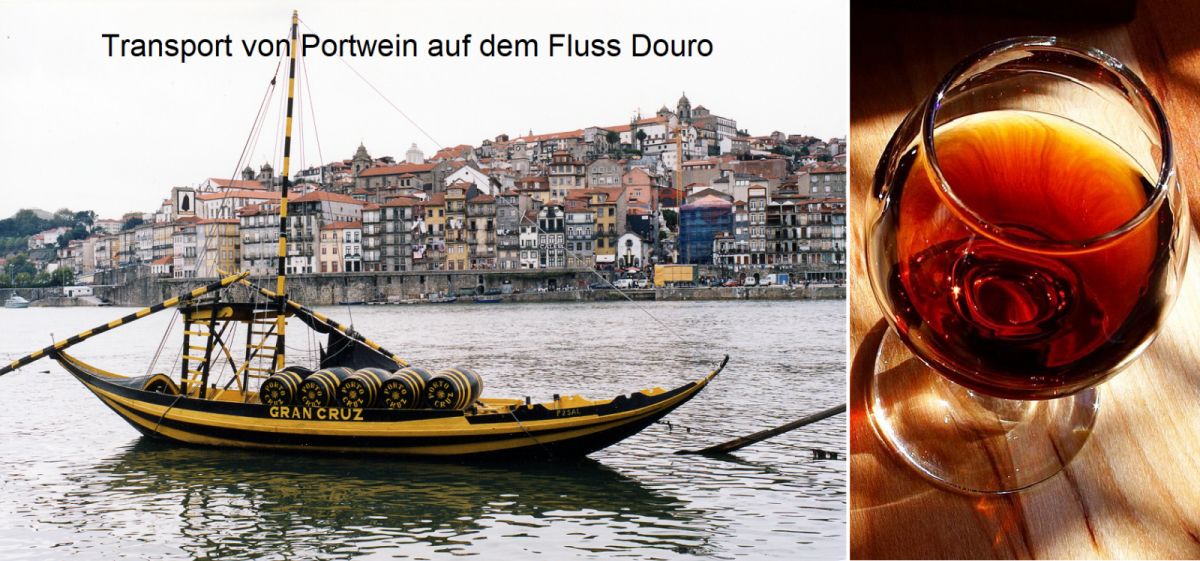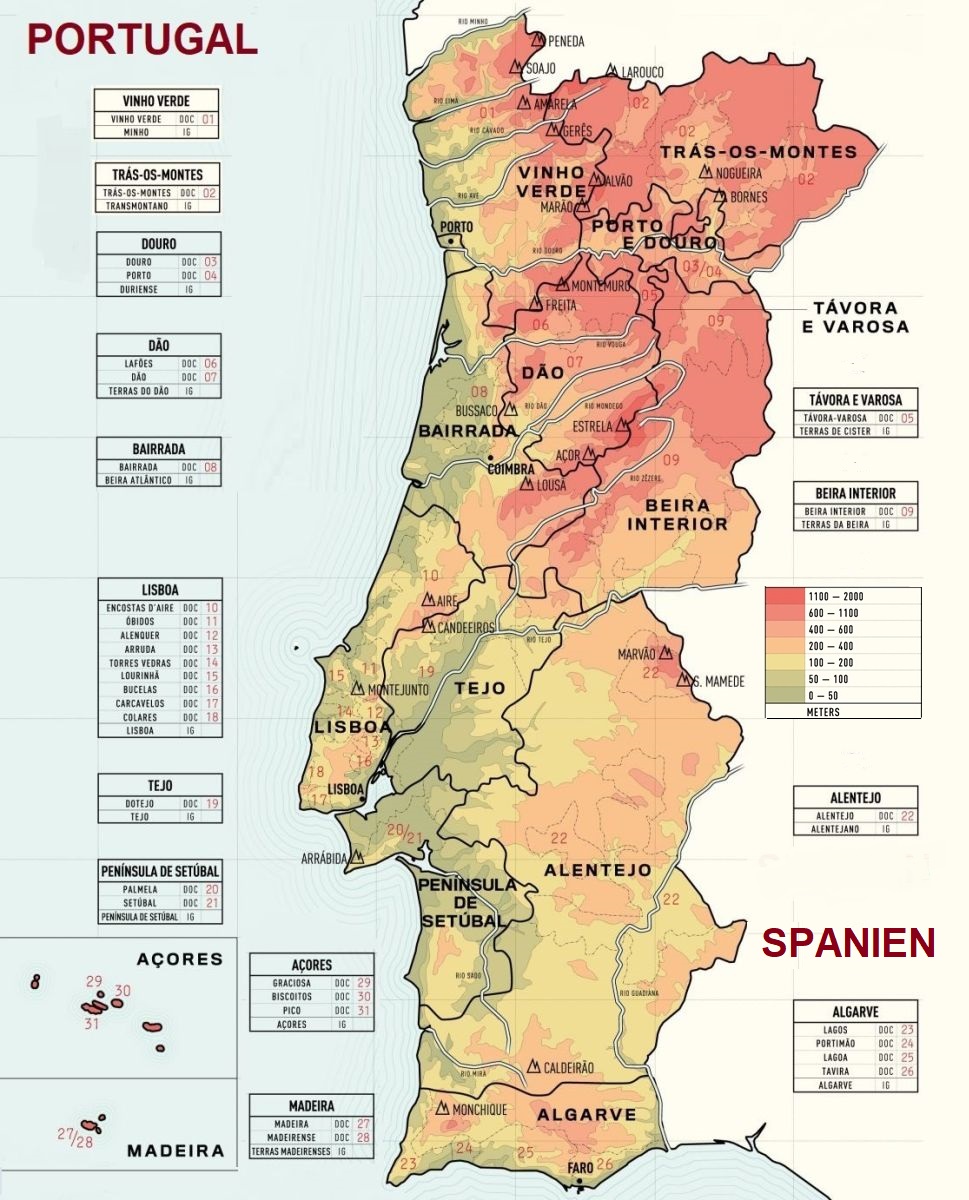Results
2,284 Results
Loading more Results ...
Loading more Results ...
Wine regions in Portugal 17 growing regions
Description to Portugal
The semi-presidential Republic of Portugal with its capital Lisbon(Lisboa) on the Iberian Peninsula in south-west Europe covers 92,212 km². The country is bordered to the west and south by the Atlantic Ocean and to the east and north by Spain. The national territory also includes two island groups in the Atlantic. These are the Azores (2,351 km²) 1,369 km west of the mainland and Madeira with Porto Santo (801 km²) 951 km from the mainland and 737 km from the coast of Africa(Morocco).

History
In ancient times, Phoenicians, Greeks and Romans brought vines to the Iberian Peninsula. Although viticulture stagnated under the long Moorish rule from the 8th to the 12th century, it did not come to a complete standstill despite the ban on alcohol. As in many other countries, the Roman Catholic monastic order of the Cistercians had a decisive influence on viticulture, founding 18 monasteries in Portugal in the 12th century. King Dinis (1279-1325) promoted agriculture and viticulture to such an extent that a merchant fleet could be built up with the proceeds.
The Kingdom of Portugal initiated the Age of Discovery in the 15th century. Under the Avis royal dynasty, especially Emmanuel I (1469-1521), Portugal rose to become a leading European trading and maritime power and created the first and one of the largest colonial empires with extensive possessions in Africa, Asia and South America. In the colonies, the introduction and planting of European vines had a significant influence on the development of viticulture. Muscat and Malvasia grapes were planted on the island of Madeira. A flourishing wine trade with England developed.

Port wine
Portugal's most famous wine is port. Its great triumph began when the Methuen Treaty was signed between England and Portugal in 1703. This provided for large tariff reductions for the import of Portuguese wines. As early as 1756, the Prime Minister Marquês de Pombal (1699-1782) laid down precise demarcations for the Douro region. Alongside Chianti, this was one of the very first areas to be controlled in terms of origin.
The Factory House, opened in 1790 in Porto, where the British factors negotiated their business, played a special role in the port wine trade. A wine similar to port is Madeira from the island of the same name in the Atlantic. Big export hits with 40% of the total volume are the rosé wine Mateus from the Sogrape company, created in 1942, and similar products such as Lancers from the Fonseca company. With a share of over 50%, Portugal is the world's largest producer of cork stoppers.
Soil & climate
The elongated country has a wide variety of soil types from north to south as well as a very different climate with continental and Mediterranean influences and sometimes extreme fluctuations in summer and winter. In the cool, rainy and fertile north of Portugal, fresh wines that can be consumed rather quickly grow on barren, sandy granite soils. In the Minho region, it can rain almost every day, while the left bank of the River Guadiana in the Alentejo or parts of the Douro region often have to go many months without a drop of rain.
The climate in the Alentejo and Dão areas varies between Mediterranean and continental with large temperature fluctuations between day and night as well as summer and winter. The areas of Bairrada and Colares are influenced by the Atlantic Ocean with extreme climatic fluctuations with lots of rain and cool temperatures. The climate in the central agricultural heartland is mild all year round. It has mineral soils interspersed with gravel and benefits from its location on the River Tagus. In the far south, the climate is hot and 50% of cork production comes from here.
Regions & growing areas
Viticulture is practised throughout the mainland and to a significant extent on the two archipelagos. In the 19th century, most of Portugal's vineyards were destroyed by mildew and phylloxera. Reconstruction only began in 1930. After the end of the dictatorship in 1974, the switch from the production of cheap mass-produced wines to quality products began. Viticulture is an important economic factor in Portugal, as around 15% of the population live from it.
Alentejo
- Alentejano (IGP)
- Alentejo (DOC)
- Borba (DOC)
- Évora (DOC)
- Granja-Amareleja (DOC)
- Moura (DOC)
- Portalegre (DOC)
- Redondo (DOC)
- Reguengos (DOC)
- Vidigueira (DOC)
Algarve
Azores
Beiras
- Bairrada (DOC)
- Beira Atlântico (IGP)
- Beira Interior (DOC)
- Dão (DOC)
- Lafões (DOC)
- Távora-Varosa (DOC)
- Terras da Beira (IGP)
- Terras de Císter (IGP)
- Terras do Dão (IGP)
Douro
- Duriense (IGP)
- Porto e Douro for port wine (DOC)
Lisboa
- Alenquer (DOC)
- Arruda (DOC)
- Bucelas (DOC)
- Carcavelos (DOC)
- Colares (DOC)
- Encostas d'Aire (DOC)
- Lisboa - formerly Estremadura (IGP)
- Lourinhã - brandy (DOC)
- Óbidos (DOC)
- Torres Vedras (DOC)
Madeira
- Madeira (DOC)
- Madeirense (DOC)
- Terras Madeirenses (IGP)
Península de Setúbal
Tejo
Trás-os-Montes
- Transmontano (IGP)
- Trás-os-Montes (DOC)
Vinho Verde
- Minho - formerly Rios do Minho (IGP)
- Vinho Verde (DOC)

Grape varieties and vineyards
In 2022, the vineyards covered 190,981 hectares of vines and the wine production volume was 6.85 million hectolitres. White wines make up 30% and rosé and red wines 70%. These are often cuvées made from several grape varieties. The 250 or so grape varieties, most of which are indigenous, were also largely cultivated as Gemischter Satz in the past.
The frequent synonyms and homonyms cause confusion, but DNA analyses are clarifying more and more origins. In the 1980s, mainly due to EU regulations regarding quality wines, the cultivation of single-varietal vineyards began. Many of the grape varieties can also be found in neighbouring Spain (sometimes with different names). The grape variety index with the top 50 (Kym Anderson statistics):
Grape variety |
Colour |
Synonyms or name in Portugal |
hectares |
| Tempranillo | Red | Aragonez, Tinta Roriz, Tinta Santiago | 17.014 |
| Touriga Franca | red | formerly Touriga Francesa | 14.217 |
| Castelão Francês | red | Castelão, João Santarém | 12.580 |
| Fernão Pires | white | Maria Gomes, Molinha | 12.138 |
| Touriga Nacional | red | Carabuñera, Mortagua, Touriga Fina | 11.411 |
| Trincadeira Preta | red | Tinta Amarela, Trincadeira | 10.493 |
| Baga | red | Baga de Louro, Moreto | 6.750 |
| Síria | white | Códega, Crato Branco, Roupeiro | 6.438 |
| Arinto | white | Arinto de Bucelas, Pedernã | 5.409 |
| Tinta Barroca | red | Boca de Mina, Tinta Barocca | 4.733 |
| Alicante Henri Bouschet | red | - | 4.547 |
| Loureiro | white | Branco Redondos, Loureira, Marqués | 4.402 |
| Vinhão | red | Sousão, Espadeiro Basto | 4.055 |
| Syrah | red | - | 4.017 |
| Marufo | red | Brujidera, Mourisco | 3.367 |
| Malvasia Fina | white | Arinto do Dão, Assario, Boal, Gual | 2.922 |
| Alvarelhão | red | Brancelhão | 2.860 |
| Palomino | white | Listrão, Malvasia Rei, Palomino Fino | 2.594 |
| Mencía | red | Jaen, Jaen du Dão, Loureiro Tinto | 2.561 |
| Cabernet Sauvignon | red | - | 2.346 |
| Caladoc | red | - | 2.180 |
| Rabigato | white | Preto Gordo, Tinta Carvalha du Douro | 1.969 |
| Malvasia Preta | red | Moreto, Mureto, Pinheira Roxa | 1.933 |
| Antão Vaz | white | Antonio Vaz | 1.768 |
| Trajadura | white | Treixadura (Spain), Trajadura Branca | 1.550 |
| Azal Branco | white | Azal, Azal da Lixa, Carvalha | 1.443 |
| Alfrocheiro | red | Albarín Negro, Tinta Bastardinha | 1.206 |
| Trousseau Noir | red | Bastardinho, Bastardo | 1.166 |
| Rufete | red | Rifete, Rufeta, Tinta Pinheira | 1.145 |
| Tinta Carvalha | red | Preto Gordo, Tinta Carvalha du Douro | 1.113 |
| Diagalves | white | Carnal, Dependura, Diego Alves | 1.090 |
| Bical | white | Bical de Bairrada, Borrado das Moscas | 1.076 |
| Muscat Blanc | white | Moscatel Branco, Moscatel do Douro | 1.031 |
| Viosinho | white | Veozinho Verdeal | 916 |
| Damaschino | white | Alicante Branco | 880 |
| Malvasia de Colares | white | Malvasía | 801 |
| Santarena | red | Santareno | 724 |
| Avesso | white | Bornal, Bornão, Borracal Branco | 699 |
| Vital | white | Boal Bonifacio, Malvasia Corada | 659 |
| Negramoll | red | Mollar, Saborinho, Tinta de Madeira | 605 |
| Godello | white | Gouveio, Verdelho do Dão | 584 |
| Gouveio Real | white | - | 581 |
| Rabo de Ovelha | white | Rabigato, Rabo de Ovelha de Cola Res | 563 |
| Chardonnay | white | - | 547 |
| Carrega Branco | white | Branca de Monterrei, Carrega | 512 |
| Muscat d'Alexandrie | white | - | 509 |
| Cornifesto | red | Cornifesto Tinto | 508 |
| Merlot | red | - | 482 |
| Seara Nova | white | - | 471 |
| Manteúdo | white | Listán de Huelva | 466 |
Wine categories / quality levels
In August 2009, the EU wine market regulation came into force with fundamental changes to wine designations and quality levels. The following new designations and quality levels have been introduced (see also details under Quality System). The traditional terms Vinho Regional and DOC are still possible as alternatives:
- Vinho (formerly Vinho de Mesa or table wine) = wine
- IGP or IG or alternatively VR = regional wine
- DOP or alternatively DOC = quality wine
Vinho
Wine without narrower designation of origin. This lowest quality level usually involves blends from different growing regions.
IGP or IG (Indicação Geográfica Protegida) or
VR (VinhoRegional)
Regional wine with a protected geographical indication. The regulations are considerably less strict than DOC. The regulations contain certain criteria, such as grape variety and alcohol content, but offer relatively wide leeway. In principle, all grape varieties authorised in the region can be used as an alternative, but at least 85% must come from the area. There are 14 areas of country wine.
IPR (Indicacão de Proveniencia Regulamentada)
The former preliminary stage IPR to DOC was discontinued in 2011. Most of the former IPR areas were upgraded to DOC as part of a reorganisation.
DOP (Denominação de Origem Protegida) or
DOC (Denominacão de Origem Controlada)
Quality wine with protected designation of origin. Grape varieties, minimum maturation periods in barrels and bottles, minimum values for alcohol content, acidity and total extract (dry extract), as well as colour and aroma are prescribed. A sensory and analytical test must be carried out before marketing. There are 31 quality wine areas.
Further regulations
For the age or maturation of a wine, there are the designations Verde (green, no ageing), Maduro (old or matured in the barrel), Reserva (red wines three years old, one of which in the bottle, white wine one year, of which six months in the bottle), Garrafeira (like Reserva and higher alcohol content) and Velho (red wine three years, white wine two years). The degrees of sweetness indicated on the label are seco = dry, meio seco = semi-dry, meio doce = semi-sweet and doce (also adamado, suave) = sweet.
Map: © Goruma
Flag: by Columbano Bordalo Pinheiro, Public domain, Link
Coat of arms: by Tonyjeff, Public domain, Link
Douro: by Thomas Istvan Seibel; from Wikipedia, CC BY-SA 3.0, Link
Port wine glass: By Jon Sullivan, Public domain, Link
Portugal map viticulture: ViniPortugal
Text source Soil & climate: Rui Falcão
Classified wine producers in Portugal 12
find+buy for Portugal 79
Recent wines 748
 Caves Messias - Soc. Agrí. e Comercial dos Vinhos Messias, S.A.
— Beiras
2020 Bairrada DOC Brut Grande Cuvée
86 WP
very good
Up to 12.90 €
Caves Messias - Soc. Agrí. e Comercial dos Vinhos Messias, S.A.
— Beiras
2020 Bairrada DOC Brut Grande Cuvée
86 WP
very good
Up to 12.90 €

 Herdade dos Lagos
— Alentejo
2021 VR Alentejano Rosé "HDL"
85 WP
very good
8.50 €
Herdade dos Lagos
— Alentejo
2021 VR Alentejano Rosé "HDL"
85 WP
very good
8.50 €

 Herdade dos Lagos
— Alentejo
2021 VR Alentejano Branco "HDL"
86 WP
very good
8.50 €
Herdade dos Lagos
— Alentejo
2021 VR Alentejano Branco "HDL"
86 WP
very good
8.50 €

 Herdade dos Lagos
— Alentejo
2020 VR Alentejano Aragonez "HDL"
85 WP
very good
Herdade dos Lagos
— Alentejo
2020 VR Alentejano Aragonez "HDL"
85 WP
very good
